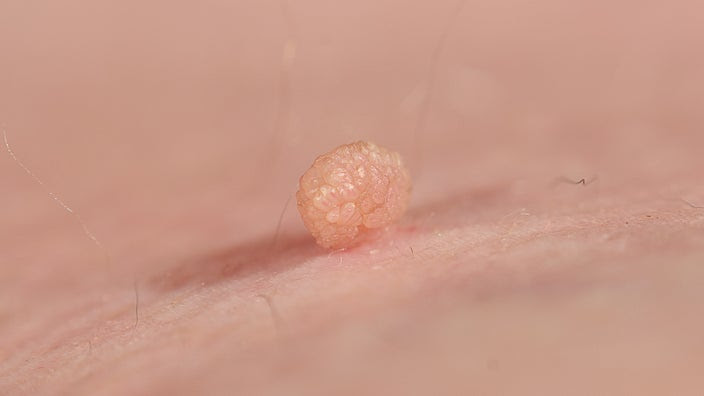Tetiana Mandziuk/iStock via Getty Images Plus

As dermatologists, one of the most common things we’re asked about is skin tags. People ask questions like: What are they? Why do I get them? How do I get rid of them?
Skin tags — also called acrochordons — are common, non-cancerous skin growths. Here, we’ll review everything you need to know about skin tags, including what may cause them, how they can be removed, and if you should treat them at home.
What exactly are skin tags?
Skin tags are soft growths that hang on a thin piece of tissue called a stalk. They’re usually pretty small — about 2 to 5 mm — but can grow to several centimeters. They’re made of loose collagen tissue and blood vessels (parts of normal skin). Skin tags can be skin-colored or darker. Some people have just one skin tag while others can have dozens or more.
People of any age can get skin tags, but they are much more common in adults. In fact, almost half of adults will have one at some point in their life.
Common places you get skin tags
Skin tags can happen anywhere on your body. But they’re most common in skin folds, often in areas such as the:
- Armpits
- Neck
- Groin folds
- Inner thighs
- Eye area
- Genitals
- Area under your breasts
What causes skin tags?
We’re not entirely sure what causes skin tags. There are some theories about why they develop, such as:
- From skin friction or rubbing
- As part of the normal aging process
- Associated with insulin resistance
- From human papillomavirus virus (HPV), which is the same virus family that causes warts
Some factors may increase your risk of getting skin tags. Examples include:
- Having family members with them
- Being pregnant
- Having higher levels of blood sugar (glucose), which can be associated with prediabetes or diabetes
- Having overweight or obesity
- Having other signs of metabolic syndrome (like high cholesterol)
- Having a rare genetic condition (like Birt-Hogg-Dubé syndrome)
When should you be worried about skin tags?
In general, skin tags are harmless and nothing to worry about. They aren’t usually associated with any health problems. But, there are some situations when you may want to be checked out by your provider. These include:
- If a skin tag changes in size or color quickly
- If it bleeds, hurts, or bothers you in any other way
- If you’re not sure it’s a skin tag (other skin growths, like moles, can look similar)
How do you get rid of skin tags?
Skin tags generally don’t need to be removed. People may choose to remove them for cosmetic reasons, because they cause discomfort, or they get caught on clothes or jewelry. It’s best to see your provider to remove skin tags.
Here are common ways your healthcare provider may remove skin tags:
- Cutting, which uses surgical scissors or a blade to cut skin tags off
- Freezing (called cryotherapy), which uses liquid nitrogen spray to freeze them
- Burning, which uses an electric current passed through a wire to burn them off
Do at-home treatments for skin tags work?
Many different at-home skin tag removal products are available, but they may not be effective and can have side effects. In general, providers don’t recommend that you remove skin tags yourself. Some risks of at-home removal include:
- Bleeding
- Getting a skin infection
- Scarring
- Damaging healthy skin
- Removing something other than a skin tag
- Not removing the whole thing
What happens if you accidentally pull off a skin tag?
If a skin tag accidently gets pulled off, it’s usually not a problem. If it bleeds, apply firm pressure for a few minutes until the bleeding stops. Look for signs of infection as it heals, including pain that lasts, spreading redness, or any drainage. If this happens, see your provider.
The bottom line
Skin tags are common, non-cancerous skin growths. People may choose to remove them for cosmetic reasons or because they get caught in clothing or jewelry. The best way to remove skin tags is to visit your healthcare provider. At-home treatments don’t always work and can cause problems like a skin infection.

Leave a Reply